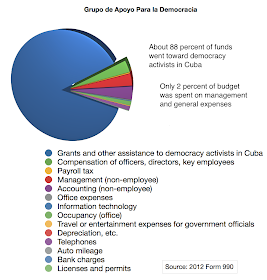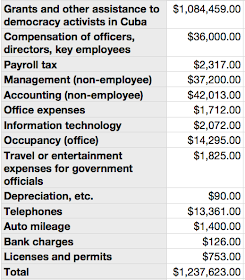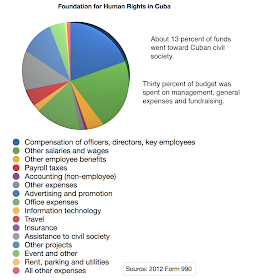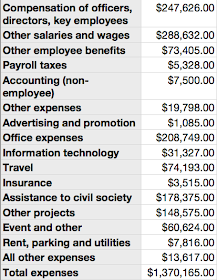
Dos destinos del dinero recibido por organizaciones “anticastristas” de MIAMI para proyectos sobre Cuba
El periodista Tracey Eaton ha supuesto metodológicamente que el
dinero recibido para proyectos vinculados con la democratización cubana (entiéndase subversión NR)
se puede dividir según las direcciones que se asignen a la hora de su
inversión.
Sin manifestar -de entrada- que un destino sea mejor que otro, Eaton establece:
1-Están quienes creen que esos fondos, aun cuando se reciban en Miami, deben invertirse principalmente en Cuba.
Un ejemplo de organización que opta por esa perspectiva sería el
Grupo de Apoyo a la Democracia (Frank Hernández Trujillo) que en el 2012
declaró en el FORMULARIO-990 (https://docs.google.com/file/d/0B6Mo1c2bIFLWaDdINXQtWmlGcjQ/edit) una cantidad ingresada de 1,237,623 dólares, de los que envió a Cuba 1,084,459 dólares distribuidos en 450 ayudas. El 88% del presupuesto.
2-La otra posición o enfoque es la de quienes invierten más en el
apoyo desde el exterior. Un ejemplo sería la Fundación de Derechos
Humanos en Cuba, que en su FORMULARIO-990 de 2012 (https://docs.google.com/file/d/0B6Mo1c2bIFLWSVBiTWcwLWpDM0k/edit) reportó una cantidad ingresada de 1,370,165 dólares, de los que envió para el desarrollo de la sociedad civil 178,375 dólares.
http://eichikawa.com
Democracy aid: Two radically different approaches
One Miami non-profit sends the vast majority of its resources to
democracy activists in Cuba, the other spends most of its money in South
Florida.
Is one strategy better than the other? Or does democracy-building in Cuba require a multifaceted approach?
Grupo de Apoyo para la Democracia en Cuba, or GAD, reported revenues of $1,237,623 on its 2012 Form 990. It spent $1,084,459 - or nearly 88 percent of its budget - on grants and other assistance destined for 450 aid recipients in Cuba.
The Foundation for Human Rights in Cuba, or FHRC, reported revenues of $1,370,165 on its 2012 Form 990. It sent $178,375 to an undisclosed number of Cubans to boost civil society.
The foundation spent 15 percent of its funds on office expenses as compared to less than 2 percent for the GAD.
The foundation's salaries were more than a fifth of its budget. The GAD's were less than 3 percent.
Is one strategy better than the other? Or does democracy-building in Cuba require a multifaceted approach?
Grupo de Apoyo para la Democracia en Cuba, or GAD, reported revenues of $1,237,623 on its 2012 Form 990. It spent $1,084,459 - or nearly 88 percent of its budget - on grants and other assistance destined for 450 aid recipients in Cuba.
The Foundation for Human Rights in Cuba, or FHRC, reported revenues of $1,370,165 on its 2012 Form 990. It sent $178,375 to an undisclosed number of Cubans to boost civil society.
The foundation spent 15 percent of its funds on office expenses as compared to less than 2 percent for the GAD.
The foundation's salaries were more than a fifth of its budget. The GAD's were less than 3 percent.
 |
| Group puts a priority on putting aid in the hands of activists. |
 |
| Grupo de Apoyo para la Democracia expenses |
 |
| The foundation has higher overhead than the GAD. |
 |
| Foundation for Human Rights in Cuba expenses |
The foundation says its mission is to:
- Empower Cuban civil society to build a durable democracy in Cuba;
- Enhance on-island civil society's awareness and effectiveness in non-violent activism;
- Facilitate on-island civil society with civic training materials, communication equipment, thematic "know-how" manuals (e.g. entrepreneurship, micro-financing, etc.) and financial support;
- Create awareness and document, within the island and the international community, human rights violations;
- Collaborate with international and on-island non-governmental organizations to provide for additional expertise and resources;
- Provide humanitarian aid.
The group lists two significant accomplishments:
- Promoting "human rights in Cuba through preparation of various publications both in video and in written form for training and awareness purposes to empower Cuban civil society."
- Sending "video productions equipment, training materials and other aid" to Cuba.
The foundation spent $338,276 to carry out the first task and $610,972
for the second. I assume those costs include not just materials, but
salaries and all the other expenses needed to carry out the tasks.
I wonder what strategies are most effective in Cuba. Is it best to spread ideas and raise awareness? Spread around some cold, hard cash? Or maybe a little of both.
I wonder what strategies are most effective in Cuba. Is it best to spread ideas and raise awareness? Spread around some cold, hard cash? Or maybe a little of both.
Tracey Eaton
http://alongthemalecon.blogspot.com/2014/02/democracy-aid-two-radically-different.html

No hay comentarios:
Publicar un comentario